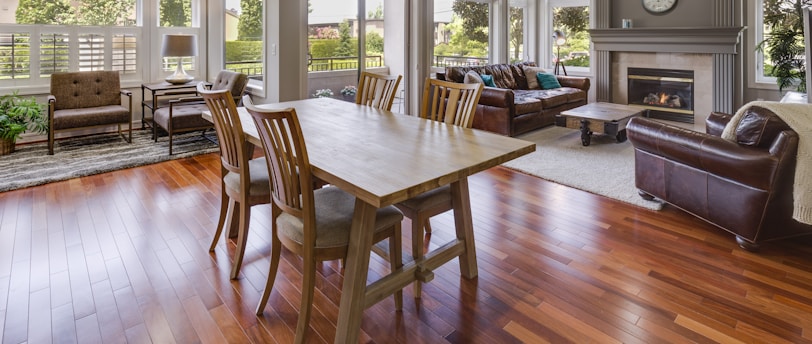Ask About Our Price Match Guarantee
Floor Care and Maintenance: Keep Your Floors Clean and Stain-Free
Learn the best practices for floor care and maintenance to keep your floors looking clean and stain-free. Discover effective tips and tricks for cleaning hardwood, tile, carpet, and other types of flooring to maintain their quality and longevity. Read our blog post now!
1/14/20244 min read


Floor Care & Maintenance
Maintaining clean and well-maintained floors is essential for both commercial and residential settings. Different types of flooring require specific care and cleaning methods to ensure their longevity and appearance. In this article, we will discuss the various types of flooring commonly used in both settings and provide insights into the best practices for floor care and maintenance.
Types of Flooring in Commercial and Residential Settings
1. Hardwood Flooring: Hardwood floors are a popular choice for both commercial and residential spaces due to their timeless appeal and durability. They add warmth and elegance to any setting. However, they require regular maintenance to prevent scratches, water damage, and fading. Hardwood floors are best suited for low to medium-traffic areas.
2. Carpet Flooring: Carpet flooring offers comfort and insulation, making it a popular choice for bedrooms, living rooms, and offices. Regular vacuuming is essential to remove dust, dirt, and allergens. Stain prevention is crucial, and immediate action should be taken to remove spills and stains. Carpet flooring is ideal for areas with low to medium foot traffic.
3. Tile Flooring: Tile floors, such as ceramic or porcelain, are commonly found in kitchens, bathrooms, and commercial spaces. They are highly durable and resistant to stains, making them easy to clean. Regular sweeping and mopping help maintain their appearance and prevent grime buildup. Tile flooring is suitable for areas with high foot traffic.
4. Vinyl Flooring: Vinyl flooring is versatile, affordable, and available in various designs, making it a popular choice for both commercial and residential settings. Regular sweeping and damp mopping are sufficient to keep vinyl floors clean. However, caution should be exercised to prevent scratches from heavy furniture or sharp objects.
5. Laminate Flooring: Laminate flooring offers the look of hardwood or tile at a more affordable price. It is relatively easy to clean and maintain, requiring regular sweeping and occasional damp mopping. However, it is not as durable as hardwood or tile and may be prone to scratching.
Importance of Floor Care and Maintenance
Regular floor care and maintenance are essential for several reasons. Firstly, it helps prolong the lifespan of the flooring material, saving you money on repairs or replacements. Secondly, well-maintained floors enhance the overall aesthetics of the space, creating a positive impression on visitors or potential buyers. Lastly, clean floors contribute to a healthier indoor environment by reducing allergens and preventing the growth of mold or bacteria.
Best Practices for Floor Care and Maintenance
1. Regular Cleaning: Regular cleaning is crucial for maintaining the cleanliness and appearance of all types of flooring. This includes sweeping or vacuuming to remove loose dirt and dust. For hard surfaces, damp mopping with a mild cleaner is recommended. It is important to avoid excessive moisture, as it can damage certain flooring materials.
2. Stain Prevention: To prevent stains, it is important to address spills and accidents immediately. Blotting the affected area with a clean cloth or paper towel can help absorb the liquid before it seeps into the flooring. Avoid using harsh chemicals or abrasive cleaners, as they can damage the surface.
3. Stain Removal: Different types of stains require specific removal methods. For example, vinegar and water solutions work well for removing coffee or tea stains from carpets, while baking soda paste can help remove stubborn stains from tile grout. It is advisable to test any cleaning solution on a small, inconspicuous area before applying it to the entire stain.
4. Floor Mats and Rugs: Placing floor mats or rugs at entrances and high-traffic areas can help reduce the amount of dirt and debris that gets tracked onto the floors. Regularly cleaning or replacing these mats is essential to prevent the accumulation of dirt and moisture.
5. Avoiding Abrasive Tools: When cleaning floors, it is important to avoid using abrasive tools or harsh brushes that can scratch or damage the surface. Instead, opt for soft microfiber mops or cloths that effectively capture dirt without causing any harm.
Cleaning Tools for Floor Care
1. Vacuum Cleaners: Vacuum cleaners are essential for maintaining carpeted areas. They effectively remove dirt, dust, and allergens from the fibers, keeping the carpets clean and fresh.
2. Mops: Mops are versatile tools used for cleaning various types of flooring. Microfiber mops are particularly effective in capturing dirt and debris without leaving streaks or residue.
3. Brooms: Brooms with soft bristles are ideal for sweeping hard surfaces, such as hardwood or tile floors. They help remove loose dirt and debris before mopping.
4. Steam Cleaners: Steam cleaners use hot water vapor to sanitize and deep clean floors. They are particularly useful for removing stains and killing bacteria without the need for harsh chemicals.
5. Floor Polishers: Floor polishers or buffers are used to restore the shine and luster of hard flooring surfaces, such as hardwood or vinyl. They help remove scuffs and scratches, giving the floors a polished finish.
Frequently Asked Questions about Floor Care and Maintenance
1. How often should I clean my floors?
The frequency of floor cleaning depends on the foot traffic and the type of flooring. Generally, high-traffic areas should be cleaned daily or as needed, while low-traffic areas can be cleaned weekly.
2. Can I use bleach to remove stains from my carpet?
It is generally not recommended to use bleach on carpets, as it can cause discoloration or damage to the fibers. Instead, opt for carpet stain removers or natural solutions like vinegar and water.
3. How do I remove scratches from hardwood floors?
Minor scratches can be buffed out using a wood floor cleaner and a soft cloth. Deeper scratches may require professional refinishing.
4. Are steam cleaners safe for all types of flooring?
Steam cleaners are safe for most types of flooring, including tile, laminate, and vinyl. However, they should not be used on hardwood floors, as excessive moisture can cause damage.
5. Can I use vinegar to clean my tile floors?
Yes, a mixture of vinegar and water can effectively clean tile floors. However, it is important to avoid using vinegar on natural stone tiles, as it can etch the surface.
Conclusion
Proper floor care and maintenance are essential for preserving the appearance and longevity of different types of flooring in both commercial and residential settings. By following the best practices outlined in this guide, you can ensure that your floors remain clean, stain-free, and in excellent condition for years to come.
Request a FREE Quote
Contact Us
7030 Woodbine Ave
Markham, ON L3R 6G2
+1 647-886-3599 info@officecleaningservicespro.net
Our Services
HVAC Installation/Maintenance
